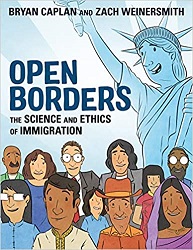The Science and Ethics of Immigration
written by Bryan Caplan
artwork by Zach Weinersmith
First Second, 2019. 249 pages.
Starred Review
Review written December 6, 2019, from a library book
This is a graphic novel about the case for, yes, open borders. And yes, it’s got science and ethics and statistics to back it up.
I’ve long said about children’s nonfiction, that the graphic novel format is a fantastic way to get facts across. It turns out to also be true about facts and current issues for adults.
I’ll admit up front that I was leaning toward advocating for open borders – because from my perspective it certainly seems the more Christian thing to do. But I wasn’t sure about answers to the various objections.
This book is written by a professor at George Mason University (down the road from me), and he has answers to a whole lot of objections. He also has ideas for opening up immigration that fall short of open borders, but that are still better than our current situation.
It would be easier to make a case against open borders if the United States hadn’t had almost open borders (“with infamous exceptions”) until the 1920s. In fact, my own ancestors came to America long before the 1920s, so they didn’t have to worry about legal or illegal immigration. In fact, most of my ancestors came before the United States existed. They came to English colonies, a lot of them looking for freedom of religion. Many of them did not, in fact, speak English. I have a copy of a will from an ancestor who fought in the Revolutionary War. His will was written in German. (No, he didn’t come to fight. He was one of the “Pennsylvania Dutch.”)
No, that’s not covered in this book, but that explains my leaning toward allowing immigrants today to do the same thing my ancestors did – come to America looking for a better life.
The author begins by talking about “global Apartheid.” The reason people from poor countries don’t emigrate to richer countries is that the richer countries don’t allow it. He takes a hard look at the ethics of that.
Then he uses statistics and studies to show that immigration helps the world. Immigrants are more productive in first world nations, and everyone benefits. Global productivity dramatically goes up when everyone can live where they want.
But he does proceed to take on arguments against immigration. He uses statistics to show they’re misguided. I especially like the section on Numeracy where he shows that the fear of criminal immigrants is flat-out innumerate.
Another chapter I like is where he looks at utilitarianism, egalitarianism, libertarianism, cost-benefit analysis, meritocracy, Christianity, and Kantianism – and shows that all of these world views can be used to support open borders. In the Christianity section, the author asks, “And who is my neighbor? People on my street? My town? My state? The whole country?” Jesus says, “Funny, you’re not the first person to ask. Let me tell you a little story about a Samaritan.”
But don’t take my word for it. Like I said, the graphic format is a very effective way to make an argument – but you do need to see it for yourself.
Open borders are not only the ethical thing to do. They have a dramatically net positive effect for everyone.
bcaplan.com
smbc-comics.com
firstsecondbooks.com
Find this review on Sonderbooks at: www.sonderbooks.com/Nonfiction/open_borders.html
Disclosure: I am an Amazon Affiliate, and will earn a small percentage if you order a book on Amazon after clicking through from my site.
Disclaimer: I am a professional librarian, but I maintain my website and blogs on my own time. The views expressed are solely my own, and in no way represent the official views of my employer or of any committee or group of which I am part.
What did you think of this book?
